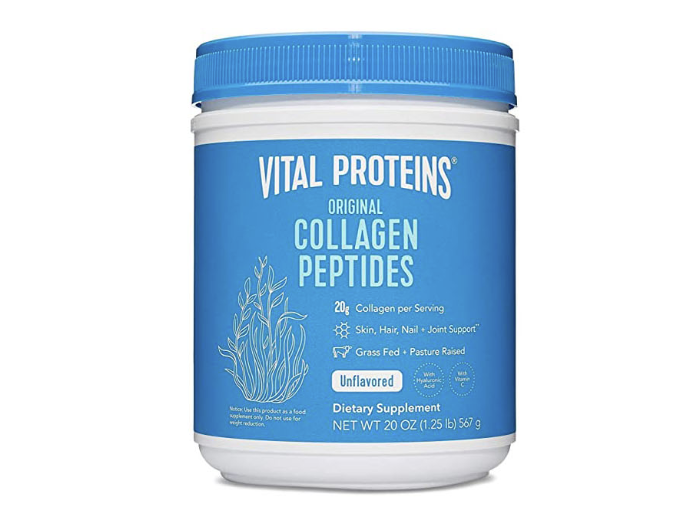
Collagen has gotten a lot of hype the past few years, boasting benefits to skin health, muscle injury repair, and joint cartilage to name a few. Many products have been made such as collagen coffee creamer, collagen powders, collagen skin cream, and many more. Collagen forms our connective tissues, fascia, and is a major component in tendons, ligaments, and bone. So, its reason to believe that collagen is very important in the body. Collagen supplements have many forms. Bovine, marine, shark, and even poultry are common sources of collagen.
When we exercise, especially under resistance; micro-trauma occurs in the muscles activating the body’s built-in repair system. When the body heals following a workout, scar tissue is initially laid down to stabilize the tissue. When the tissues heal, the scar tissue is remodeled into healthy tissue. The problem is that scar tissue is highly disorganized and acts as a temporary solution, a quick fix. However, if this tissue never heals, it becomes fibrotic meaning sticky. This prevents optimal movement from occurring. Over time, dysfunctional tissue puts stress on other muscles, passive tissues (non contractile such as ligaments and joint tissues), and requires more energy to maintain the same output.
For example, if your car has a misalignment in the front axle, the other tires are stressed abnormally. The frame of the car gets excess wear and tear and eventually the drive train gets affected. The same goes with your body. Fascia covers every single muscle fiber, tendon, ligament, and body part. The fascial system is similar to a spider web, you know, the one in the attic that glimmers in the sun as you look at the cob web wondering how big the spider must be who wove it. However, the web is wet, hydrated almost like a viscous substance. This web of tissue holds our body together. Every single movement you do is felt throughout the entire body. Fascia is highly innervated, almost 10 times more nerve endings than that of muscle. These nerve endings sense, position, vibration, but most importantly movement. The fascial system is vital to our movements either allowing for, or preventing the body from moving in a direction. Fascia also acts as a force transfer tissue. All of your muscles pull, contracting with force. The fascia transfers the forces to the bones which move the joints. So, if we imagine the fascia isn’t able to glide and slide due to adhesions, there will be a loss of function, even if it’s small.
So where does collagen come into the story? Collagen is the primary protein that makes up your fascia. Supplementing collagen in the research surprisingly hasn’t shown many benefits to recovery. However, when collagen is combined with a complete protein such as whey; the results are almost a 33% increase in muscle protein synthesis. The implications of this are crucial. This means that 33% faster healing occurs following a dose of collagen plus whey protein. As runners, we utilize the same fascial systems over and over and over and over again. The tissue adapts, growing stronger ligaments, bones, and connective tissue systems. For example, your IT band which is simply a densified, strong piece of fascia thickens when we run as if it is meant to hold things together. When we run, the shock that we absorb vibrates the fascia jarring the muscles, bones and skin. The fascial system adapts by thickening, which enhances the energy transfer.
Piezoelectricity is a large word. Let’s break this down into something digestible. “Piezio” means pressure or a mechanical force, “electrical” just means electric and “ity” means the state of. We put this together and it means “The condition (or phenomenon) of electricity generated by pressure.” This energy creates a neural network in the brain. A map, a sensory web. Think of the fascial system as an extension of the nervous system. This web of tissue drastically enhances the surface area of the sensory neurons in the body. The fascial system is the size of a tennis court if we were to illustrate the surface area in the body. This is remarkable when we look at the body as a whole instead of just the parts. The brain monitors every movement, every second of activity, every day. If the brain senses poor movement in a region, it responds accordingly, amplifying, or cranking up the RPMs of the muscles to protect the joints.
It’s extremely important to support our body’s innate ability to heal itself if we have the nutrients to heal and recover. So, to wrap up this conversation, collagen is very important to our body especially after exercise so we can move without restriction. Our own body is holding us back.
🌊 Marine Collagen (from fish)
- Best for skin & anti-aging
- Smaller peptides = potentially even better absorption
- Downside: more expensive
🐄 Bovine Collagen (from cow hide)
- Rich in Type I & III = great for skin, muscle, bone
- Widely available and affordable
🐓 Chicken Collagen (sternum cartilage)
- High in Type II = best for joints and cartilage
🥚 Eggshell Membrane Collagen
- Contains Type I, V, and X
- Beneficial for skin and connective tissue, but less studied
Ohio Sports Chiropractic and Rehab
📍 10360 Northfield Rd, Northfield, OH 44067
📞 (330) 908-0203
🌐 ohiosportschiropractic.com
